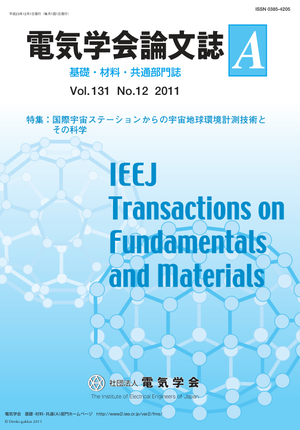The Global Lightning and Sprite Measurement (GLIMS) Mission on International Space Station
The Global Lightning and Sprite Measurement (GLIMS) Mission on International Space Station
カテゴリ: 論文誌(論文単位)
グループ名: 【A】基礎・材料・共通部門
発行日: 2011/12/01
タイトル(英語): The Global Lightning and Sprite Measurement (GLIMS) Mission on International Space Station
著者名: Tomoo Ushio (Osaka University), Mitsuteru Sato (Hokkaido University), Takeshi Morimoto (Osaka University), Makoto Suzuki (JAXA/ISAS), Hiroshi Kikuchi (Osaka University), Atsushi Yamazaki (JAXA/ISAS), Yukihiro Takahashi (Hokkaido University), Yasuhide Hobara (The University of Electro-Communications), Umran Inan (Stanford University), Ivan Linscott (Stanford University), Yuji Sakamoto (Tohoku University), Ryohei Ishida (Osaka Prefecture University), Masayuki Kikuchi (National Institute of Polar Research), Kazuya Yoshida (Tohoku University), Zen-Ichiro Kawasaki (Osaka University)
著者名(英語): Tomoo Ushio (Osaka University), Mitsuteru Sato (Hokkaido University), Takeshi Morimoto (Osaka University), Makoto Suzuki (JAXA/ISAS), Hiroshi Kikuchi (Osaka University), Atsushi Yamazaki (JAXA/ISAS), Yukihiro Takahashi (Hokkaido University), Yasuhide Hobara (The University of Electro-Communications), Umran Inan (Stanford University), Ivan Linscott (Stanford University), Yuji Sakamoto (Tohoku University), Ryohei Ishida (Osaka Prefecture University), Masayuki Kikuchi (National Institute of Polar Research), Kazuya Yoshida (Tohoku University), Zen-Ichiro Kawasaki (Osaka University)
キーワード: lightning,transient luminous event,international space station
要約(英語): Global Lightning and sprIte MeasurementS (GLIMS) is a mission on the International Space Station (ISS) to detect and locate optical transient luminous events (TLEs) and associated lightning simultaneously from the non-sun-synchronous orbit. It is scheduled to be launched from Japan in January, 2012 as part of the multi-mission consolidated equipment on the Japanese Exposure Module (JEM). Our mission's goals are (1) to detect and locate lightning and sprites within storm scale resolution over a large region of the Earth's surface along the orbital track of the ISS without any bias, (2) to clarify the mechanism by which sprites are generated, and (3) to identify the conditions under which TLEs occur. To achieve these goals, two CMOS cameras, six Photometers, a VLF receiver and VHF interferometer with two antennas are installed at the bottom of the module to observe the TLEs, as well as causative lightning discharges at nadir direction during day and night time. Though the luminous events' so-called sprites, elves and jets have been investigated by numerous researchers all over the world based mainly on ground observations, some important problems have not been fully understood yet. These include the generation mechanisms of columniform fine structures and horizontal offset of some sprites from the parent lightning discharges. In the JEM-GLIMS mission, observations from our synchronized sensors will shed light on the unsolved problems mentioned above regarding TLEs and causative lightning discharges. In this presentation scientific background, instrumentation, and project summaries are given.
本誌: 電気学会論文誌A(基礎・材料・共通部門誌) Vol.131 No.12 (2011) 特集:国際宇宙ステーションからの宇宙地球環境計測技術とその科学
本誌掲載ページ: 971-976 p
原稿種別: 論文/英語
電子版へのリンク: https://www.jstage.jst.go.jp/article/ieejfms/131/12/131_12_971/_article/-char/ja/
受取状況を読み込めませんでした


